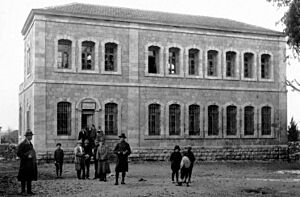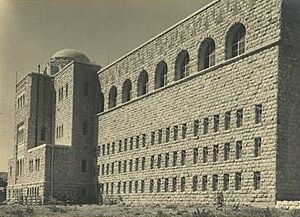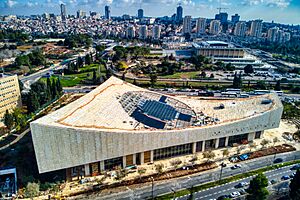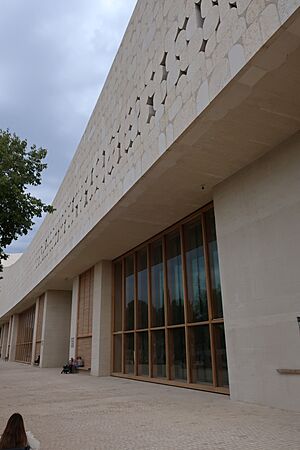National Library of Israel facts for kids
Quick facts for kids National Library of Israel |
|
|---|---|
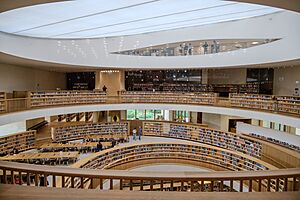 |
|
| The reading room in the new building (2023) | |
| Country | Israel |
| Established | 1892 |
| Reference to legal mandate | The Legal Deposit of generally available documents |
| Location | Jerusalem |
| Coordinates | 31°46′38″N 35°12′12″E / 31.77722°N 35.20333°E |
| Collection | |
| Items collected | Unique collections of manuscripts, special collections of books, music, radio and television programmes, film, theatre, maps, posters, photographs, electronic documents and newspapers. |
| Size | 5 million volumes |
| Other information | |
| Budget | Approximately 100 million NIS |
| Director | Oren Weinberg |
| Staff | 367 |
The National Library of Israel (NLI) is a special library that collects and protects the cultural treasures of Israel and Jewish heritage. It holds over five million books and is located in Jerusalem, near the Knesset, which is Israel's parliament.
The library has the world's largest collections of books and items related to Jewish culture, known as Hebraica and Judaica. It also holds many rare and one-of-a-kind manuscripts, books, and artifacts.
Contents
The Library's Long History
The story of the National Library of Israel is a journey through time, with many changes and moves.
A Dream of a Library (1892–1925)
The idea for a Jewish national library came from a man named Joseph Chazanovitz. He dreamed of a place that would hold all books written by Jewish authors, no matter the language. Chazanovitz collected about 15,000 books, which became the first collection of the future national library.
In 1892, a library called the B'nai Brith library opened in Jerusalem. It was the first public library for the Jewish community in the region. This library was the beginning of what would become the National Library of Israel.
Part of the Hebrew University (1925–2007)
In 1920, plans were made for the Hebrew University of Jerusalem. The B'nai Brith book collection was chosen to be the university's main library. When the university opened on Mount Scopus in 1925, the books were moved there.
In 1948, it became difficult to reach the university on Mount Scopus. Most of the books were moved to a temporary location in the Rehavia neighborhood of Jerusalem. By then, the collection had grown to over one million books. In 1960, the books were moved again to a new, larger building on the Givat Ram campus of the university.
Over time, this building started to have problems like leaks and pests. It was clear that the library needed a new home.
Becoming the National Library (2007)
In 2007, the Israeli government passed the National Library Law. This law officially named the library "The National Library of the State of Israel." It was no longer just a university library. It became an independent company, owned by the Government of Israel, the Hebrew University, and other organizations.
A New Home for the Library
In 2014, plans for a brand-new building for the library were revealed. The building was designed by the famous architecture firm Herzog & de Meuron. Construction began in 2016.
The new building officially opened its doors to the public on October 29, 2023.
Temporary Closure in 2020
In August 2020, the library had to close for a few weeks because of the COVID-19 pandemic in Israel. During this time, many employees worked from home, and the library offered many of its services online.
What the Library Does
The library has a very important job to do.
The Library's Mission
The library's main goal is to collect and save important materials. By law, it must receive two copies of everything printed in Israel, including books, newspapers, and magazines. This law also includes music, videos, and other media.
The library also collects:
- Everything published about Israel and the Land of Israel.
- Everything published about Judaism and the Jewish people from anywhere in the world.
- Everything published in Hebrew or other Jewish languages like Yiddish and Ladino.
Putting History Online
The library is working hard to scan its collections and make them available online for free. This means people from all over the world can see rare and ancient manuscripts, like the famous Worms Mahzor from the 13th century, right from their computers.
The library is also scanning over 2,500 rare books and manuscripts from the Islamic world. These works are in Arabic, Persian, and Turkish and date back hundreds of years.
Amazing Special Collections
The library is home to many unique and fascinating collections.
Personal Papers of Famous People
The library holds the personal papers and archives of many important Jewish figures.
- Isaac Newton: The library has some of Sir Isaac Newton's writings on religious topics. These papers show his deep interest in ancient texts and his thoughts about the future.
- Martin Buber: The personal papers of this famous philosopher are kept here.
- Gershom Scholem: The library has the personal library and papers of this important scholar of Jewish mysticism.
- Max Brod: The library holds the papers of Max Brod, who was a close friend of the famous writer Franz Kafka. These papers include many of Kafka's important writings.
Books from Palestinian Libraries
After the 1948 Arab-Israeli War, books from the homes of many Palestinians who left Jerusalem and other cities were brought to the library. About 6,000 of these books are still in the library today. They are marked with the label "AP," which stands for "Abandoned Property." These books are listed in the library's catalog and can be read by the public.
See also
 In Spanish: Biblioteca Nacional de Israel para niños
In Spanish: Biblioteca Nacional de Israel para niños
- Judaica Archival Project
- List of national and state libraries
- Union List of Israel, combined library catalog with over 5 million entries
Images for kids
-
The Ardon stained-glass windows in the old library building.



